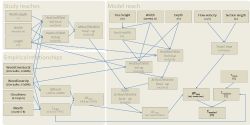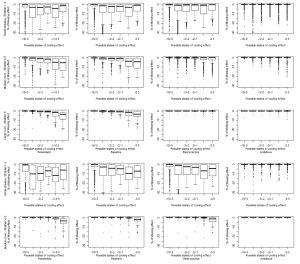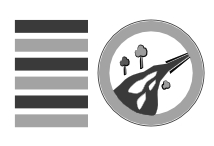Most rivers in temperate ecoregions like Central Europe are naturally bordered by deciduous trees, shading the water surface and thus reducing direct sunlight or “direct solar radiation”, which is the most important factor influencing river water temperature.
Direct solar radiation and water temperature increase in spring and are highest in summer. On top of this seasonality, there are daily fluctuations. Water temperature is lowest at the end of the night just before dawn and highest in the afternoon, when input of direct sunlight is still high and other heat sources peak.
Climate change will increase air temperature, which in turn will increase mean summer water temperature by up to several degrees. So daily fluctuations will start from a higher level. Hence, limiting daily maximum water temperature by shading will become more important.
Keeping river water cool is important because most animals like fish and aquatic insects prefer and growth is highest at moderate water temperatures. Even more important, warmer water holds less dissolved oxygen needed by these animals for respiration. At high water temperature dissolved oxygen concentrations are finally reaching lethal lower limits.
To model the ecologically most relevant daily maximum water temperature in summer, we used a statistical model and expert knowledge:
First, we derived a statistical relationship between woody cover (as a simple proxy for shading) and daily maximum water temperature in summer (May-Aug) based on measured data from a set of small lowland streams. The empirical study and resulting relationship are described in detail in Kail et al. (link to paper).
Second, expert knowledge on basic physical principles was used to build a Bayesian Belief Network (BBN), adjusting the results of the empirical relationship to other streams differing from the studied reaches. This BBN assesses the probability of reaching a specific daily maximum water temperature based on simple input information like woody cover, cloudiness, wetted width and depth or channel slope (more information on the BBN).
The BBN was then applied for three different scenarios (read more) in two case-study catchments, to assess catchment wide effects.
Knowledge rules and BBN:
The statistical relationship derived from the empirical study predicts daily maximum water temperature in summer. More precisely, it predicts how water temperature changes along the reach from the upstream start to the downstream end (ΔTmax) due to the change in woody cover in a 10m wide riparian buffer on each side of the river compared to the upstream conditions (ΔWood).
The empirical study revealed that the effect of woody cover on water temperature increases with daily temperature range at the upstream start of the reach Trange. In other words, the cooling effect of woody cover is higher if the water entering the reach is already “heated” (Fig. 1).
In turn, daily temperature range (Trange = Tmax - Tmin) depends on three factors:
- Woody cover upstream: If there is less woody cover upstream, the water entering the reach is heated and can be more strongly cooled by woody cover in the reach.
- Cloudiness: the less clouds, the higher direct solar radiation input heats up the water upstream, which can then be more strongly cooled by woody cover in the reach.
- Month: Daily fluctuations of water temperature seem to be generally higher in early summer (May) compared to late summer (August), resulting in a larger effect of woody cover on water temperature in early summer.
The effect of woody cover on water temperature in the empirical study is at a highly relevant scale and the largest effect occurs at a sunny day (no clouds) in May (in reaches similar to study streams with ∼ 2m wetted width, ∼ 450m length, wetted width-to-depth ratio of ∼ 17):
- Cooling ∼ 4.9°C (woody cover 0% upstream and 100% locally)
- Warming +2.9°C (woody cover 100% upstream and 0% locally)

Fig. 1: Conceptual model of how water temperature changes along a river reach from the upstream start to the downstream end (ΔTmax) due to the change in woody cover compared to the upstream conditions (ΔWood in a 10m wide riparian buffer each side).
See here for more details on the empirical study (link to paper).
See here for an interactive version of this empirical part of the BBN [link to the shiny application]
The full BBN (Fig. 2) adjusts this result of the empirical relationship to account for the following two main differences between the study reaches and the reach to be modelled (read more):
- River size: Shading by woody cover in the 10m buffer reduces the sunlit water surface, and hence, the energy available for heating the water. The BBN adjusts for differences in
- the sunlit heating surface (e.g. if the river is wide, the riparian trees are only shading parts of the river width and a sunlit water surface remains even if the whole 10m riparian buffer is covered by trees),
- water volume (water volume increases with wetted width and depth).
- Travel time: If the model reach is longer or flow velocity lower, the water is exposed to the respective conditions for a longer time (and vice versa) and the result of the empirical relationship is adjusted respectively.
If absolute mean water temperature is known, absolute daily maximum temperature at the end of the model reach can be assessed. See here for an interactive version of the full BBN [link to shiny application]

Fig. 2: Conceptual model to adjust results of the empirical relationships to the conditions in other river reaches to be modelled. Input variables are given in black, internal nodes in grey, output variables in bold.
Case-study scenario runs
The Bayesian Belief Network was applied to river segments in two contrasting case-study catchments in the lower-mountain and lowland region of Germany (Central Europe). For each river segment, the cooling predicted by the BBN given the present woody cover was compared to a potential maximum cooling when the whole 10m wide riparian buffer is forested. This gives the missing potential for cooling that is not yet used. For example, a negative percentage value of -10% for the state “-3 to -5” in the figures below indicates that the probability for a cooling by -3 to -5°C is presently 10 percentage points less than it could be in natural woody riparian corridors. Zero values indicate that the maximum cooling is reached.
This analysis resulted in the following four main findings:
“The effect of woody cover on water temperature is largest in small streams”
Woody cover can substantially reduce daily maximum water temperature in summer in small streams of Strahler order 1-3 down to -3 to -5°C (Fig. 3a, 3b baseline scenario, small streams). Therefore, the missing potential for cooling is much larger in small streams than in medium-sized rivers of Strahler order 4-5 where placing additional trees has a very low probability to result in a cooling by more than -1°C (Fig. 3a, 3b baseline scenario, medium rivers). This lower cooling effect in larger streams may be due to two factors: First, larger streams are wider and a decreasing share of the cross-section is shaded by riparian trees. Second, width:depth ratio usually decreases with stream size, meaning that depth increases more strongly than width, and in turn the water volume to be heated increases more strongly than the heating surface. This dampens daily fluctuations in water temperature (Trange) and therefore reduces the potential for cooling by shade.
“The effect of woody cover on water temperature is largest during low-flow periods in late summer”
Lower discharges in late summer (August) result in lower water depth in the BBN, reducing water volume while the heating surface remained rather constant. This increase of the heating surface per water volume more than compensates for the generally higher daily temperature range (and hence shading effect) in early summer (see section on empirical relationships). So finally, the effect of woody cover on water temperature is highest in late summer. As a consequence, woody cover effects on water temperature are also higher in streams with lower summer base-flow since this also decreases depth and increases the heating surface per water volume in summer. This is reflected by the higher missing potential in medium-sized rivers in the lower-mountain catchment with lower summer base-flows compared to the small potential in the groundwater fed lowland mid-sized rivers (Fig. 3a, 3b, baseline scenario of the medium-sized rivers).
“The maximum cooling potential can nearly be reached in an ambitious scenario”
In the ambitious scenario, we assumed that woody vegetation will be developed in a 10m wide buffer along all streams bordering agricultural and grassland areas but excluding urban area, transport and transmission lines and nature reserves of open landscapes (read more). This led to an increase in woody cover from 67% to 90% in the lower-mountain and 48% to 92% in the lowland case-study catchment, and to zero missing potentials (Fig. 3a, 3b), indicating that the maximum cooling that can be expected under near-natural conditions is nearly reached. This indicates that even in a densely populated region like Central Europe, it could be possible to make use of nearly the full potential of shading by woody cover. It is important to note that this ambitious scenario did not result in a substantial reduction of the total economic value of the riparian area in the ecosystem service analysis.
“Woody cover might mitigate substantial parts of the increase in water temperature due to climate change (until 2050)…but only in small streams”
In about one third of the small streams (Strahler order 1-3), the increase in mean water temperature due to climate change can be compensated by the cooling effect of woody cover that still can be developed along these streams. This mitigating effect is very low in medium-sized rivers (Strahler order 4-6). The increase in monthly mean water temperature was assessed based on the predicted increase in air temperature, assuming that maximum daily temperature will increase to a similar extent. This is a reasonable assumption given that cloudiness in summer and mean summer discharge are not predicted to substantially change in the case-study catchments until 2050. Similar to the missing potential, the cooling predicted by the BBN given the present woody cover was compared to the cooling assuming the woody cover of the ambitious scenario in the river segments. This extra cooling in the ambitious scenario was compared to the predicted increase in water temperature due to climate change. The probability of still observing an increase in water temperature due to climate change in the small streams after accounting for the extra cooling of the ambitious scenario was 77% and 63% in the two case-study catchments. In other words, the probability of fully compensating climate change by additional woody cover in the ambitious scenario was 23% and 37%.

Fig. 3: Boxplots of the potential missing effect in cooling (differences in probabilities between the baseline scenario and 100% woody cover) for the lower-mountain catchment Nahe (a) and lowland catchment Stever (b), for streams of Strahler order 1-3 (row 1), rivers of Strahler order 4-5 (row 2) and large rivers of Strahler order 6 (row 3, only occurring in the Nahe catchment), and the different woody cover scenarios: pessimistic (column 1), baseline (column 2), best practice (column 3) and ambitious (column 4).

Fig. 4: Boxplot of the probabilities to observe a remaining warming due to climate change if the ambitious woody cover scenario was implemented in the lower-mountain catchment Nahe (a) and lowland catchment Stever (b).
“Woody cover should preferentially be developed along small streams where the potential for cooling by woody cover is highest”
Given that small streams (Strahler order 1-3) are already fully shaded by a single line of riparian trees and cooling effects are highest in these small streams (cooling down to ∼ 5°C), there is currently a high potential for cooling and mitigating climate change effects. Downstream propagation of the cooling effect was not modelled in OSCAR but one could expect a downstream decrease of mean water temperature besides the decrease in daily maximum water temperature investigated in OSCAR. Therefore, the downstream medium-sized streams may also benefit.
“Developing woody cover along medium-sized streams is most promising in catchments with low summer discharges”
Since daily fluctuations (Trange) increase with a higher heating surface per water volume, the effect of woody cover on daily maximum water temperature is highest at low discharges. In contrast, groundwater fed streams with a high summer base-flow have a highly dampened water temperature regime and woody cover has a low effect.
The cooling effect of woody cover is potentially highly beneficial for aquatic biodiversity since most animals like fish and aquatic insects prefer and growth is highest at moderate water temperatures. Even more important, warmer water holds less dissolved oxygen needed by these animals for respiration. At high water temperature dissolved oxygen concentrations are finally reaching lethal lower limits. Furthermore, shading also supresses the excessive growth of macrophytes, which leads to oxygen depletion at night. Therefore, the low effect of woody buffers on biodiversity in the large-scale studies was surprising. The cooling effect of woody cover might be hampered or masked by other pressures like non-shaded impoundments downstream where water temperature increases dramatically, regardless of the upstream conditions.
The empirical relationship can be directly applied to comparable small lowland streams. The BBN was developed to adjust the empirical relationship to streams differing from the study streams applying basic physical principles and most probably is a good educated guess. However, the BBN still has to be rigorously tested.
This research has been funded through the 2015-2016 BiodivERsA COFUND call for research proposals, with the national funders German Federal Ministry of Education and Research (01LC1618A), Agence National de la Recherche (ANR-16-EBI3-0015-01) and Research Council of Norway (268704/E50). OSCAR project website




